Economic Factors and Men's Violence Against Women: A Study
VerifiedAdded on 2022/11/26
|9
|2775
|57
Essay
AI Summary
This essay delves into the critical public health issue of men's violence against women, examining the significant role of economic factors in perpetuating this violence. It begins by defining violence against women and highlighting its global prevalence, emphasizing the impact of poverty, income inequality, and lack of education on women's vulnerability. The essay explores how economic dependence, discrimination in the workplace, and unequal access to education contribute to violence. It discusses the need for critical economic thinking and analysis to address this issue, advocating for strategies such as promoting education, empowering women economically through business and financial independence, and advocating for equal pay. The essay also underscores the importance of women's support groups and awareness campaigns. It concludes by reiterating the multifaceted nature of the problem and the need for comprehensive interventions to address the economic and social determinants of men's violence against women.

Running head: MEN’S VIOLENCE AGAINST WOMEN 1
MEN’S VIOLENCE AGAINST WOMEN
Name of Student
Institution Affiliation
MEN’S VIOLENCE AGAINST WOMEN
Name of Student
Institution Affiliation
Paraphrase This Document
Need a fresh take? Get an instant paraphrase of this document with our AI Paraphraser
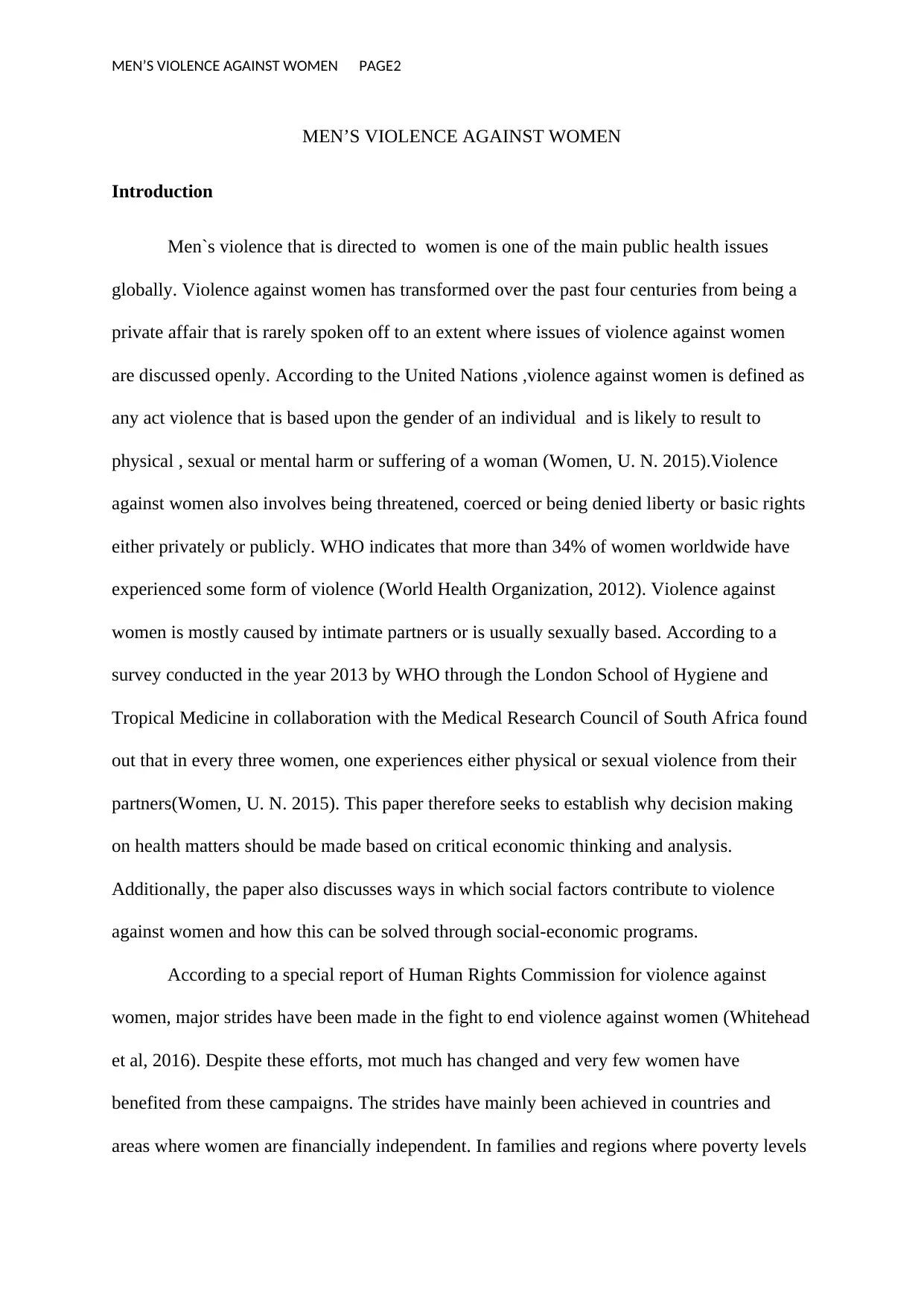
MEN’S VIOLENCE AGAINST WOMEN PAGE2
MEN’S VIOLENCE AGAINST WOMEN
Introduction
Men`s violence that is directed to women is one of the main public health issues
globally. Violence against women has transformed over the past four centuries from being a
private affair that is rarely spoken off to an extent where issues of violence against women
are discussed openly. According to the United Nations ,violence against women is defined as
any act violence that is based upon the gender of an individual and is likely to result to
physical , sexual or mental harm or suffering of a woman (Women, U. N. 2015).Violence
against women also involves being threatened, coerced or being denied liberty or basic rights
either privately or publicly. WHO indicates that more than 34% of women worldwide have
experienced some form of violence (World Health Organization, 2012). Violence against
women is mostly caused by intimate partners or is usually sexually based. According to a
survey conducted in the year 2013 by WHO through the London School of Hygiene and
Tropical Medicine in collaboration with the Medical Research Council of South Africa found
out that in every three women, one experiences either physical or sexual violence from their
partners(Women, U. N. 2015). This paper therefore seeks to establish why decision making
on health matters should be made based on critical economic thinking and analysis.
Additionally, the paper also discusses ways in which social factors contribute to violence
against women and how this can be solved through social-economic programs.
According to a special report of Human Rights Commission for violence against
women, major strides have been made in the fight to end violence against women (Whitehead
et al, 2016). Despite these efforts, mot much has changed and very few women have
benefited from these campaigns. The strides have mainly been achieved in countries and
areas where women are financially independent. In families and regions where poverty levels
MEN’S VIOLENCE AGAINST WOMEN
Introduction
Men`s violence that is directed to women is one of the main public health issues
globally. Violence against women has transformed over the past four centuries from being a
private affair that is rarely spoken off to an extent where issues of violence against women
are discussed openly. According to the United Nations ,violence against women is defined as
any act violence that is based upon the gender of an individual and is likely to result to
physical , sexual or mental harm or suffering of a woman (Women, U. N. 2015).Violence
against women also involves being threatened, coerced or being denied liberty or basic rights
either privately or publicly. WHO indicates that more than 34% of women worldwide have
experienced some form of violence (World Health Organization, 2012). Violence against
women is mostly caused by intimate partners or is usually sexually based. According to a
survey conducted in the year 2013 by WHO through the London School of Hygiene and
Tropical Medicine in collaboration with the Medical Research Council of South Africa found
out that in every three women, one experiences either physical or sexual violence from their
partners(Women, U. N. 2015). This paper therefore seeks to establish why decision making
on health matters should be made based on critical economic thinking and analysis.
Additionally, the paper also discusses ways in which social factors contribute to violence
against women and how this can be solved through social-economic programs.
According to a special report of Human Rights Commission for violence against
women, major strides have been made in the fight to end violence against women (Whitehead
et al, 2016). Despite these efforts, mot much has changed and very few women have
benefited from these campaigns. The strides have mainly been achieved in countries and
areas where women are financially independent. In families and regions where poverty levels
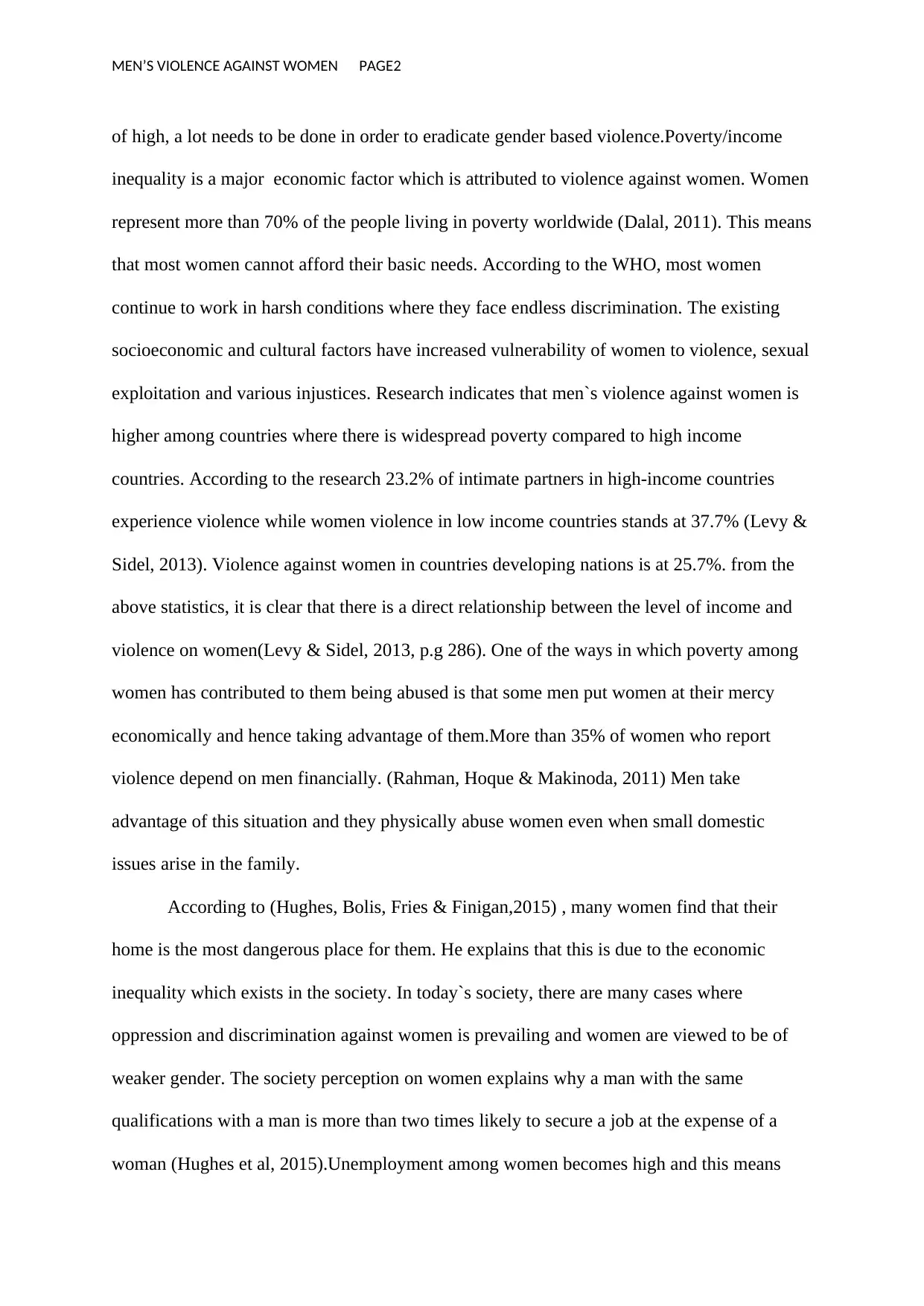
MEN’S VIOLENCE AGAINST WOMEN PAGE2
of high, a lot needs to be done in order to eradicate gender based violence.Poverty/income
inequality is a major economic factor which is attributed to violence against women. Women
represent more than 70% of the people living in poverty worldwide (Dalal, 2011). This means
that most women cannot afford their basic needs. According to the WHO, most women
continue to work in harsh conditions where they face endless discrimination. The existing
socioeconomic and cultural factors have increased vulnerability of women to violence, sexual
exploitation and various injustices. Research indicates that men`s violence against women is
higher among countries where there is widespread poverty compared to high income
countries. According to the research 23.2% of intimate partners in high-income countries
experience violence while women violence in low income countries stands at 37.7% (Levy &
Sidel, 2013). Violence against women in countries developing nations is at 25.7%. from the
above statistics, it is clear that there is a direct relationship between the level of income and
violence on women(Levy & Sidel, 2013, p.g 286). One of the ways in which poverty among
women has contributed to them being abused is that some men put women at their mercy
economically and hence taking advantage of them.More than 35% of women who report
violence depend on men financially. (Rahman, Hoque & Makinoda, 2011) Men take
advantage of this situation and they physically abuse women even when small domestic
issues arise in the family.
According to (Hughes, Bolis, Fries & Finigan,2015) , many women find that their
home is the most dangerous place for them. He explains that this is due to the economic
inequality which exists in the society. In today`s society, there are many cases where
oppression and discrimination against women is prevailing and women are viewed to be of
weaker gender. The society perception on women explains why a man with the same
qualifications with a man is more than two times likely to secure a job at the expense of a
woman (Hughes et al, 2015).Unemployment among women becomes high and this means
of high, a lot needs to be done in order to eradicate gender based violence.Poverty/income
inequality is a major economic factor which is attributed to violence against women. Women
represent more than 70% of the people living in poverty worldwide (Dalal, 2011). This means
that most women cannot afford their basic needs. According to the WHO, most women
continue to work in harsh conditions where they face endless discrimination. The existing
socioeconomic and cultural factors have increased vulnerability of women to violence, sexual
exploitation and various injustices. Research indicates that men`s violence against women is
higher among countries where there is widespread poverty compared to high income
countries. According to the research 23.2% of intimate partners in high-income countries
experience violence while women violence in low income countries stands at 37.7% (Levy &
Sidel, 2013). Violence against women in countries developing nations is at 25.7%. from the
above statistics, it is clear that there is a direct relationship between the level of income and
violence on women(Levy & Sidel, 2013, p.g 286). One of the ways in which poverty among
women has contributed to them being abused is that some men put women at their mercy
economically and hence taking advantage of them.More than 35% of women who report
violence depend on men financially. (Rahman, Hoque & Makinoda, 2011) Men take
advantage of this situation and they physically abuse women even when small domestic
issues arise in the family.
According to (Hughes, Bolis, Fries & Finigan,2015) , many women find that their
home is the most dangerous place for them. He explains that this is due to the economic
inequality which exists in the society. In today`s society, there are many cases where
oppression and discrimination against women is prevailing and women are viewed to be of
weaker gender. The society perception on women explains why a man with the same
qualifications with a man is more than two times likely to secure a job at the expense of a
woman (Hughes et al, 2015).Unemployment among women becomes high and this means
⊘ This is a preview!⊘
Do you want full access?
Subscribe today to unlock all pages.

Trusted by 1+ million students worldwide
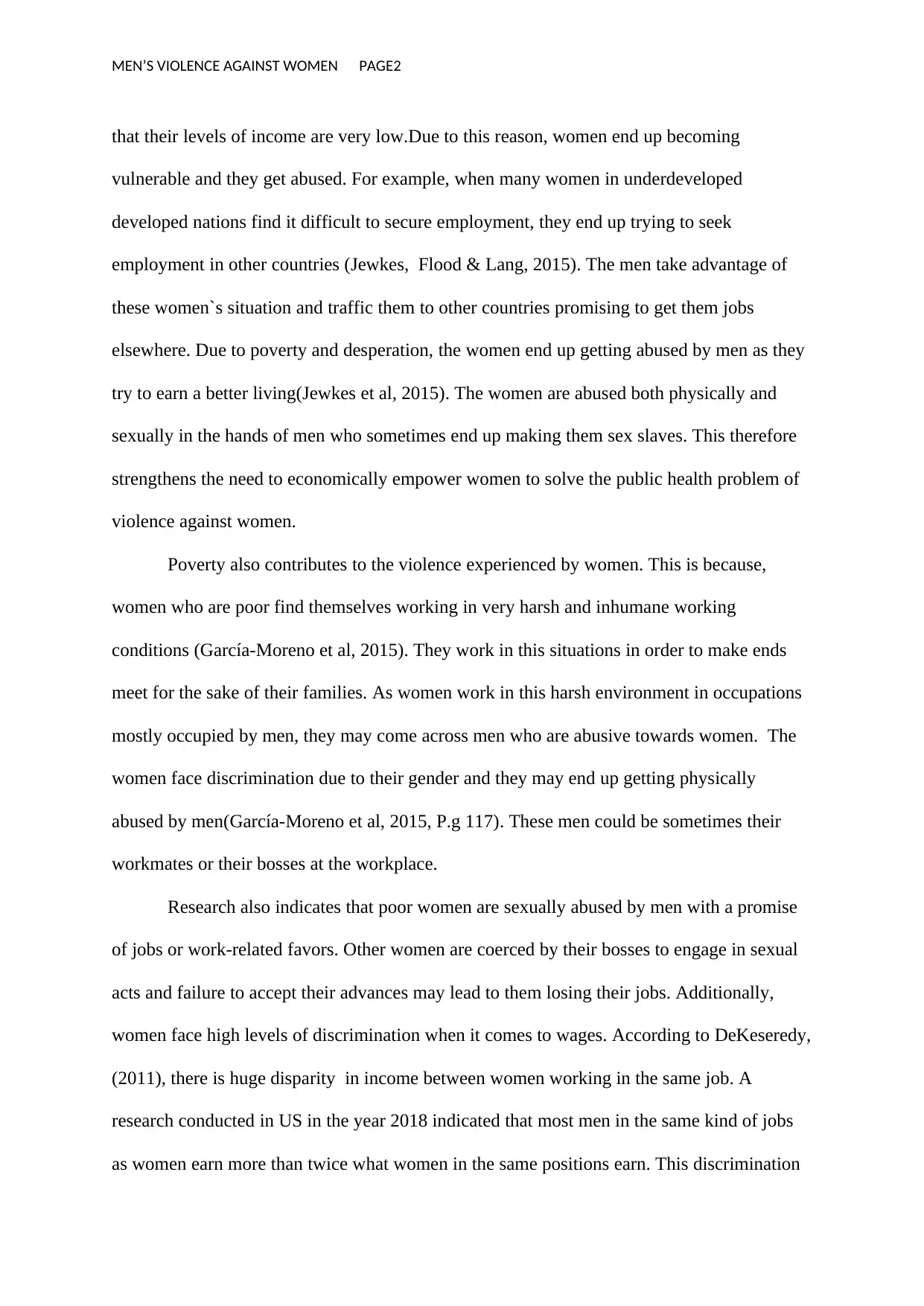
MEN’S VIOLENCE AGAINST WOMEN PAGE2
that their levels of income are very low.Due to this reason, women end up becoming
vulnerable and they get abused. For example, when many women in underdeveloped
developed nations find it difficult to secure employment, they end up trying to seek
employment in other countries (Jewkes, Flood & Lang, 2015). The men take advantage of
these women`s situation and traffic them to other countries promising to get them jobs
elsewhere. Due to poverty and desperation, the women end up getting abused by men as they
try to earn a better living(Jewkes et al, 2015). The women are abused both physically and
sexually in the hands of men who sometimes end up making them sex slaves. This therefore
strengthens the need to economically empower women to solve the public health problem of
violence against women.
Poverty also contributes to the violence experienced by women. This is because,
women who are poor find themselves working in very harsh and inhumane working
conditions (García-Moreno et al, 2015). They work in this situations in order to make ends
meet for the sake of their families. As women work in this harsh environment in occupations
mostly occupied by men, they may come across men who are abusive towards women. The
women face discrimination due to their gender and they may end up getting physically
abused by men(García-Moreno et al, 2015, P.g 117). These men could be sometimes their
workmates or their bosses at the workplace.
Research also indicates that poor women are sexually abused by men with a promise
of jobs or work-related favors. Other women are coerced by their bosses to engage in sexual
acts and failure to accept their advances may lead to them losing their jobs. Additionally,
women face high levels of discrimination when it comes to wages. According to DeKeseredy,
(2011), there is huge disparity in income between women working in the same job. A
research conducted in US in the year 2018 indicated that most men in the same kind of jobs
as women earn more than twice what women in the same positions earn. This discrimination
that their levels of income are very low.Due to this reason, women end up becoming
vulnerable and they get abused. For example, when many women in underdeveloped
developed nations find it difficult to secure employment, they end up trying to seek
employment in other countries (Jewkes, Flood & Lang, 2015). The men take advantage of
these women`s situation and traffic them to other countries promising to get them jobs
elsewhere. Due to poverty and desperation, the women end up getting abused by men as they
try to earn a better living(Jewkes et al, 2015). The women are abused both physically and
sexually in the hands of men who sometimes end up making them sex slaves. This therefore
strengthens the need to economically empower women to solve the public health problem of
violence against women.
Poverty also contributes to the violence experienced by women. This is because,
women who are poor find themselves working in very harsh and inhumane working
conditions (García-Moreno et al, 2015). They work in this situations in order to make ends
meet for the sake of their families. As women work in this harsh environment in occupations
mostly occupied by men, they may come across men who are abusive towards women. The
women face discrimination due to their gender and they may end up getting physically
abused by men(García-Moreno et al, 2015, P.g 117). These men could be sometimes their
workmates or their bosses at the workplace.
Research also indicates that poor women are sexually abused by men with a promise
of jobs or work-related favors. Other women are coerced by their bosses to engage in sexual
acts and failure to accept their advances may lead to them losing their jobs. Additionally,
women face high levels of discrimination when it comes to wages. According to DeKeseredy,
(2011), there is huge disparity in income between women working in the same job. A
research conducted in US in the year 2018 indicated that most men in the same kind of jobs
as women earn more than twice what women in the same positions earn. This discrimination
Paraphrase This Document
Need a fresh take? Get an instant paraphrase of this document with our AI Paraphraser

MEN’S VIOLENCE AGAINST WOMEN PAGE2
in terms of earning makes women vulnerable to be abused by men.This therefore means that
this is a serious public healthcare concern which should be addressed by getting women out
of poverty.
Inequalities in terms of education also contribute to the public health problem of
violence against women by men. Inequality in education has rendered women vulnerable to
violence which is meted to them by men who are either their husbands or other men in the
society (Ghosh, 2012) In many developing countries many women are not offered a chance to
go to school and get education. This is partly due to culture as well as misconceptions in
certain societies. There are many communities where women are not allowed to go to school
and this greatly renders them to poverty due to lack of education (Gupta et al, 2015). When
women are deprived of education, it denies them a chance for a better livelihood and it means
that they will struggle to earn a decent income. Men therefore take advantage of the poor
uneducated women and abuse them both physically and sexually.
According to Duflo, (2012), various improvements should be taken into consideration
for the income levels of women to be improved to help minimize cases of violence directed
towards women. From the previous research, it has been found that poverty among women
has contributed to violence against them. One of the ways in which this economic injustice
can be addressed is by advocating education of the girl child. In underdeveloped countries,
the difference between educated men and women can be as high as 80% (Ellsberg, et al.
2015). Boys go to school while girls are left to do domestic chores at home. Many girls are
also married at an early age and hence they end up losing a chance to get quality education. It
is therefore critical to address this social-economic issue in order to reduce poverty and
reduce cases of violence against women (Ellsberg et al, 2015.P.g447). A lot of resources need
to be allocated to carry out awareness campaigns on the need for education of women.when
in terms of earning makes women vulnerable to be abused by men.This therefore means that
this is a serious public healthcare concern which should be addressed by getting women out
of poverty.
Inequalities in terms of education also contribute to the public health problem of
violence against women by men. Inequality in education has rendered women vulnerable to
violence which is meted to them by men who are either their husbands or other men in the
society (Ghosh, 2012) In many developing countries many women are not offered a chance to
go to school and get education. This is partly due to culture as well as misconceptions in
certain societies. There are many communities where women are not allowed to go to school
and this greatly renders them to poverty due to lack of education (Gupta et al, 2015). When
women are deprived of education, it denies them a chance for a better livelihood and it means
that they will struggle to earn a decent income. Men therefore take advantage of the poor
uneducated women and abuse them both physically and sexually.
According to Duflo, (2012), various improvements should be taken into consideration
for the income levels of women to be improved to help minimize cases of violence directed
towards women. From the previous research, it has been found that poverty among women
has contributed to violence against them. One of the ways in which this economic injustice
can be addressed is by advocating education of the girl child. In underdeveloped countries,
the difference between educated men and women can be as high as 80% (Ellsberg, et al.
2015). Boys go to school while girls are left to do domestic chores at home. Many girls are
also married at an early age and hence they end up losing a chance to get quality education. It
is therefore critical to address this social-economic issue in order to reduce poverty and
reduce cases of violence against women (Ellsberg et al, 2015.P.g447). A lot of resources need
to be allocated to carry out awareness campaigns on the need for education of women.when
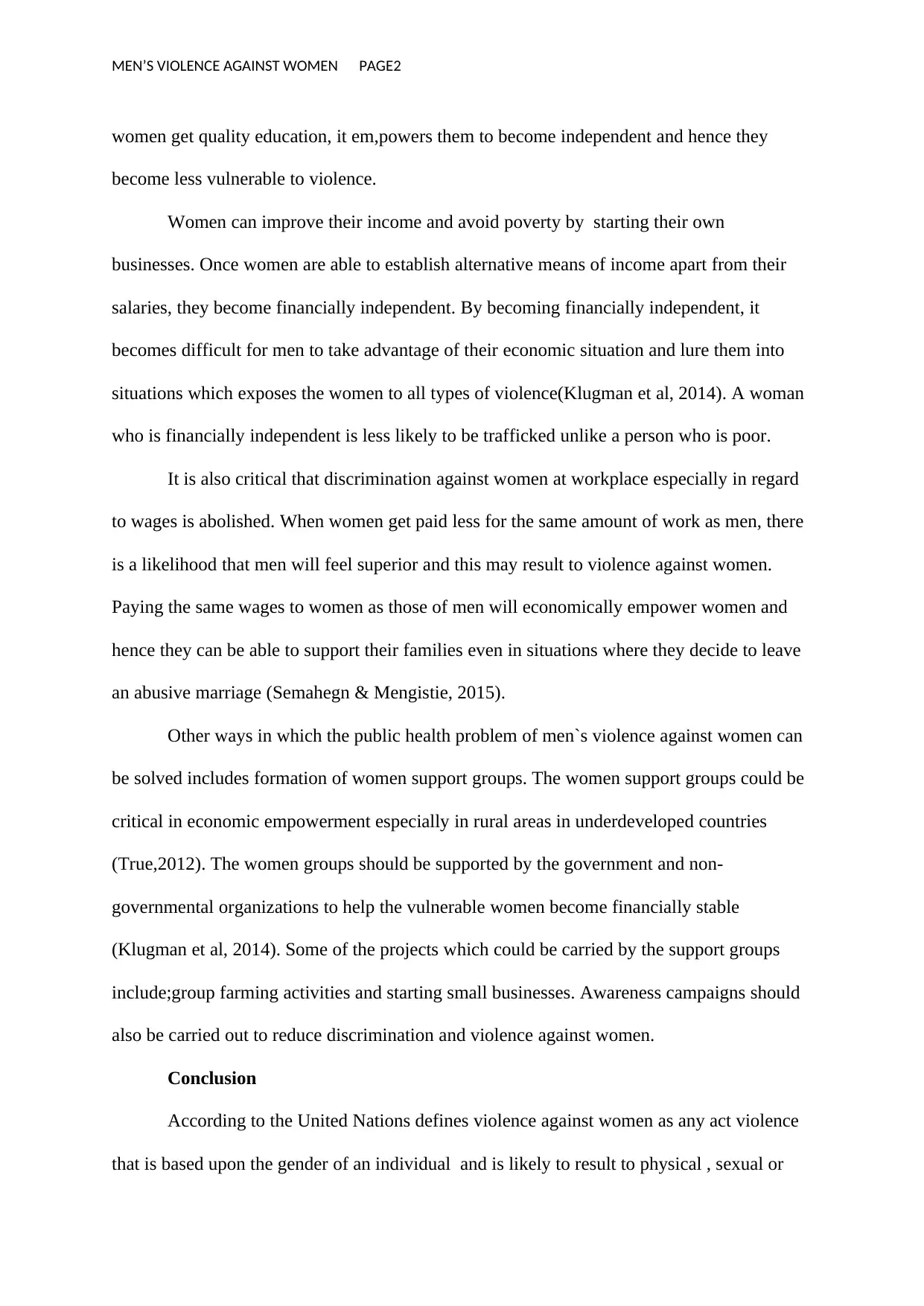
MEN’S VIOLENCE AGAINST WOMEN PAGE2
women get quality education, it em,powers them to become independent and hence they
become less vulnerable to violence.
Women can improve their income and avoid poverty by starting their own
businesses. Once women are able to establish alternative means of income apart from their
salaries, they become financially independent. By becoming financially independent, it
becomes difficult for men to take advantage of their economic situation and lure them into
situations which exposes the women to all types of violence(Klugman et al, 2014). A woman
who is financially independent is less likely to be trafficked unlike a person who is poor.
It is also critical that discrimination against women at workplace especially in regard
to wages is abolished. When women get paid less for the same amount of work as men, there
is a likelihood that men will feel superior and this may result to violence against women.
Paying the same wages to women as those of men will economically empower women and
hence they can be able to support their families even in situations where they decide to leave
an abusive marriage (Semahegn & Mengistie, 2015).
Other ways in which the public health problem of men`s violence against women can
be solved includes formation of women support groups. The women support groups could be
critical in economic empowerment especially in rural areas in underdeveloped countries
(True,2012). The women groups should be supported by the government and non-
governmental organizations to help the vulnerable women become financially stable
(Klugman et al, 2014). Some of the projects which could be carried by the support groups
include;group farming activities and starting small businesses. Awareness campaigns should
also be carried out to reduce discrimination and violence against women.
Conclusion
According to the United Nations defines violence against women as any act violence
that is based upon the gender of an individual and is likely to result to physical , sexual or
women get quality education, it em,powers them to become independent and hence they
become less vulnerable to violence.
Women can improve their income and avoid poverty by starting their own
businesses. Once women are able to establish alternative means of income apart from their
salaries, they become financially independent. By becoming financially independent, it
becomes difficult for men to take advantage of their economic situation and lure them into
situations which exposes the women to all types of violence(Klugman et al, 2014). A woman
who is financially independent is less likely to be trafficked unlike a person who is poor.
It is also critical that discrimination against women at workplace especially in regard
to wages is abolished. When women get paid less for the same amount of work as men, there
is a likelihood that men will feel superior and this may result to violence against women.
Paying the same wages to women as those of men will economically empower women and
hence they can be able to support their families even in situations where they decide to leave
an abusive marriage (Semahegn & Mengistie, 2015).
Other ways in which the public health problem of men`s violence against women can
be solved includes formation of women support groups. The women support groups could be
critical in economic empowerment especially in rural areas in underdeveloped countries
(True,2012). The women groups should be supported by the government and non-
governmental organizations to help the vulnerable women become financially stable
(Klugman et al, 2014). Some of the projects which could be carried by the support groups
include;group farming activities and starting small businesses. Awareness campaigns should
also be carried out to reduce discrimination and violence against women.
Conclusion
According to the United Nations defines violence against women as any act violence
that is based upon the gender of an individual and is likely to result to physical , sexual or
⊘ This is a preview!⊘
Do you want full access?
Subscribe today to unlock all pages.

Trusted by 1+ million students worldwide
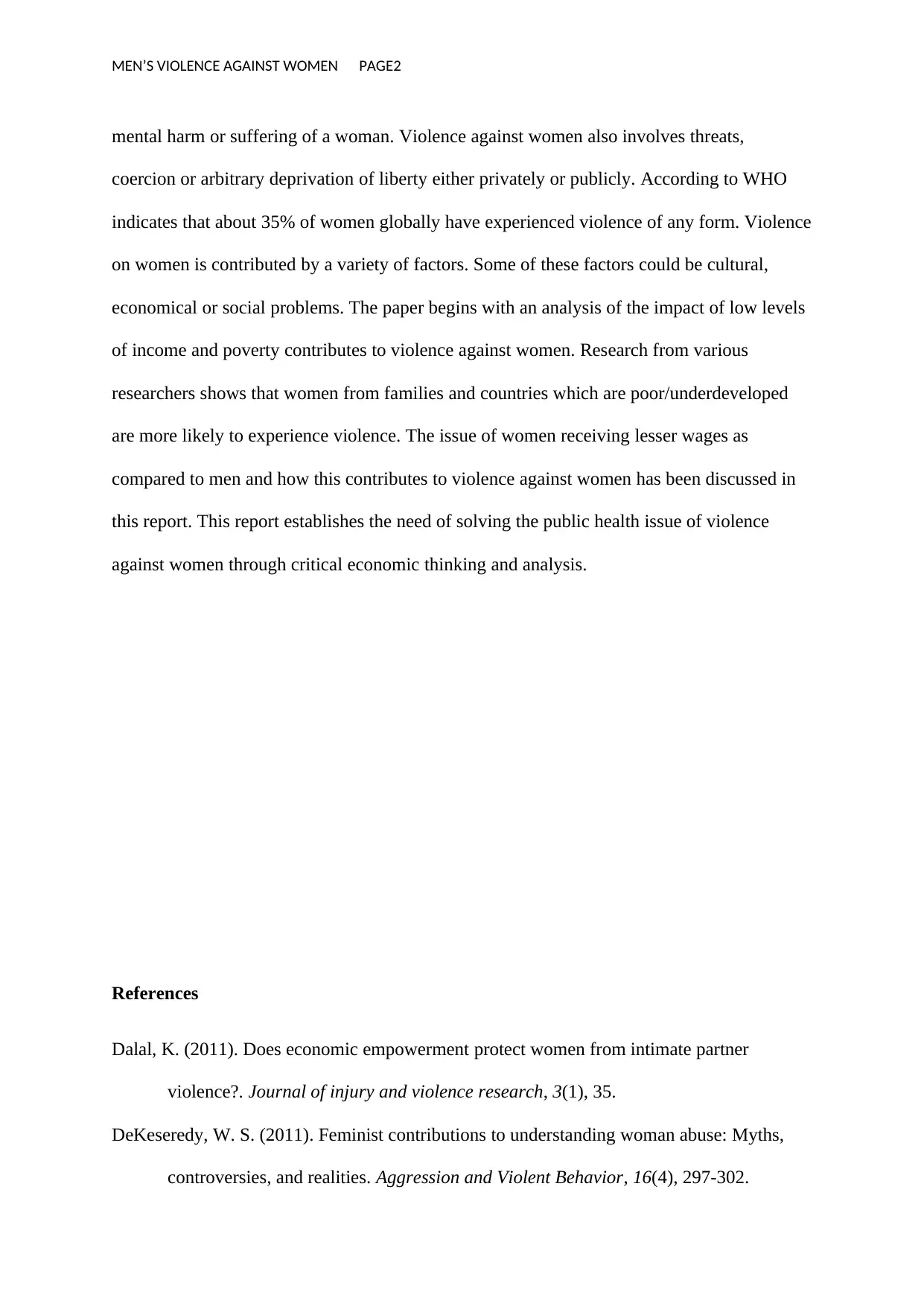
MEN’S VIOLENCE AGAINST WOMEN PAGE2
mental harm or suffering of a woman. Violence against women also involves threats,
coercion or arbitrary deprivation of liberty either privately or publicly. According to WHO
indicates that about 35% of women globally have experienced violence of any form. Violence
on women is contributed by a variety of factors. Some of these factors could be cultural,
economical or social problems. The paper begins with an analysis of the impact of low levels
of income and poverty contributes to violence against women. Research from various
researchers shows that women from families and countries which are poor/underdeveloped
are more likely to experience violence. The issue of women receiving lesser wages as
compared to men and how this contributes to violence against women has been discussed in
this report. This report establishes the need of solving the public health issue of violence
against women through critical economic thinking and analysis.
References
Dalal, K. (2011). Does economic empowerment protect women from intimate partner
violence?. Journal of injury and violence research, 3(1), 35.
DeKeseredy, W. S. (2011). Feminist contributions to understanding woman abuse: Myths,
controversies, and realities. Aggression and Violent Behavior, 16(4), 297-302.
mental harm or suffering of a woman. Violence against women also involves threats,
coercion or arbitrary deprivation of liberty either privately or publicly. According to WHO
indicates that about 35% of women globally have experienced violence of any form. Violence
on women is contributed by a variety of factors. Some of these factors could be cultural,
economical or social problems. The paper begins with an analysis of the impact of low levels
of income and poverty contributes to violence against women. Research from various
researchers shows that women from families and countries which are poor/underdeveloped
are more likely to experience violence. The issue of women receiving lesser wages as
compared to men and how this contributes to violence against women has been discussed in
this report. This report establishes the need of solving the public health issue of violence
against women through critical economic thinking and analysis.
References
Dalal, K. (2011). Does economic empowerment protect women from intimate partner
violence?. Journal of injury and violence research, 3(1), 35.
DeKeseredy, W. S. (2011). Feminist contributions to understanding woman abuse: Myths,
controversies, and realities. Aggression and Violent Behavior, 16(4), 297-302.
Paraphrase This Document
Need a fresh take? Get an instant paraphrase of this document with our AI Paraphraser
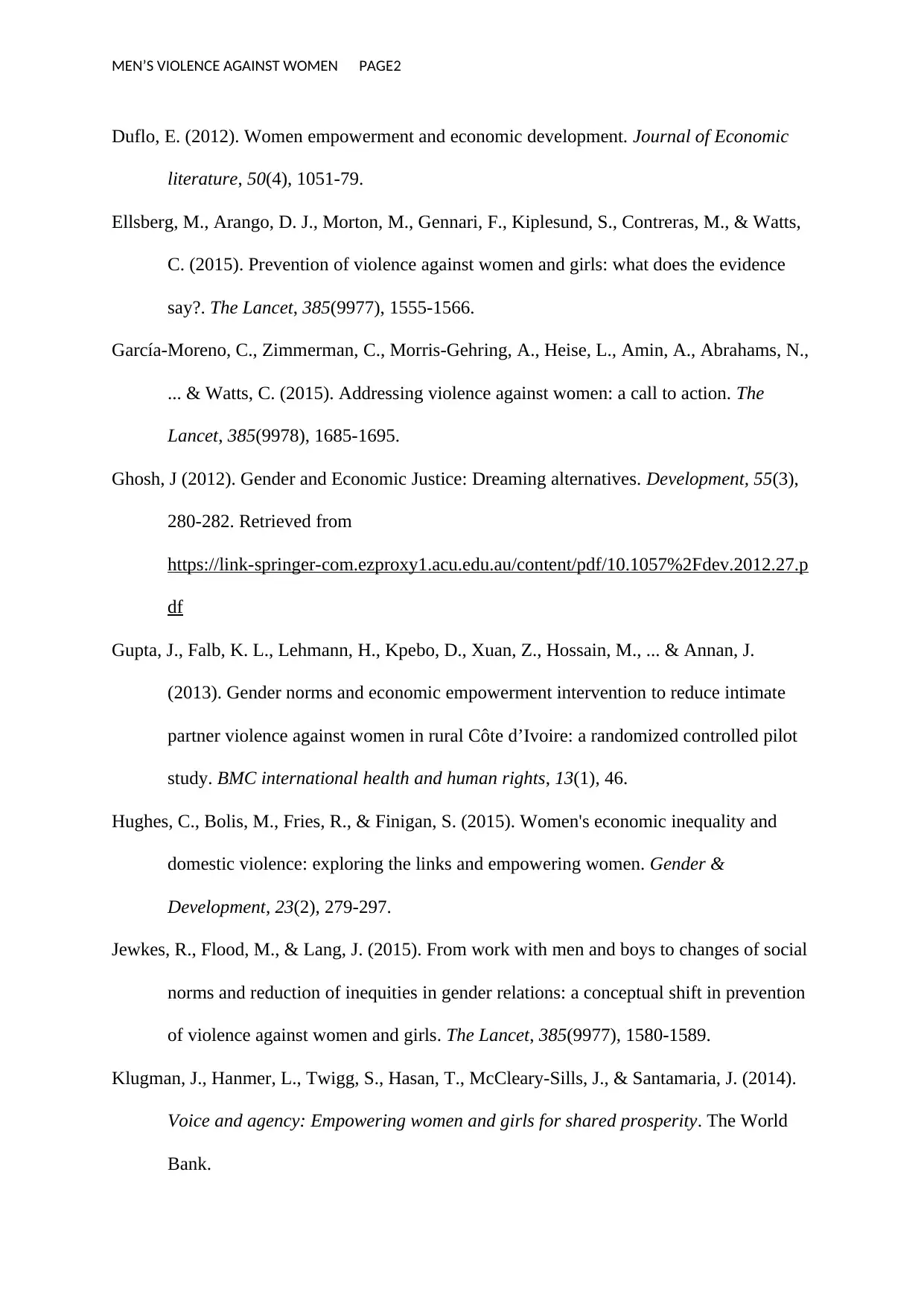
MEN’S VIOLENCE AGAINST WOMEN PAGE2
Duflo, E. (2012). Women empowerment and economic development. Journal of Economic
literature, 50(4), 1051-79.
Ellsberg, M., Arango, D. J., Morton, M., Gennari, F., Kiplesund, S., Contreras, M., & Watts,
C. (2015). Prevention of violence against women and girls: what does the evidence
say?. The Lancet, 385(9977), 1555-1566.
García-Moreno, C., Zimmerman, C., Morris-Gehring, A., Heise, L., Amin, A., Abrahams, N.,
... & Watts, C. (2015). Addressing violence against women: a call to action. The
Lancet, 385(9978), 1685-1695.
Ghosh, J (2012). Gender and Economic Justice: Dreaming alternatives. Development, 55(3),
280-282. Retrieved from
https://link-springer-com.ezproxy1.acu.edu.au/content/pdf/10.1057%2Fdev.2012.27.p
df
Gupta, J., Falb, K. L., Lehmann, H., Kpebo, D., Xuan, Z., Hossain, M., ... & Annan, J.
(2013). Gender norms and economic empowerment intervention to reduce intimate
partner violence against women in rural Côte d’Ivoire: a randomized controlled pilot
study. BMC international health and human rights, 13(1), 46.
Hughes, C., Bolis, M., Fries, R., & Finigan, S. (2015). Women's economic inequality and
domestic violence: exploring the links and empowering women. Gender &
Development, 23(2), 279-297.
Jewkes, R., Flood, M., & Lang, J. (2015). From work with men and boys to changes of social
norms and reduction of inequities in gender relations: a conceptual shift in prevention
of violence against women and girls. The Lancet, 385(9977), 1580-1589.
Klugman, J., Hanmer, L., Twigg, S., Hasan, T., McCleary-Sills, J., & Santamaria, J. (2014).
Voice and agency: Empowering women and girls for shared prosperity. The World
Bank.
Duflo, E. (2012). Women empowerment and economic development. Journal of Economic
literature, 50(4), 1051-79.
Ellsberg, M., Arango, D. J., Morton, M., Gennari, F., Kiplesund, S., Contreras, M., & Watts,
C. (2015). Prevention of violence against women and girls: what does the evidence
say?. The Lancet, 385(9977), 1555-1566.
García-Moreno, C., Zimmerman, C., Morris-Gehring, A., Heise, L., Amin, A., Abrahams, N.,
... & Watts, C. (2015). Addressing violence against women: a call to action. The
Lancet, 385(9978), 1685-1695.
Ghosh, J (2012). Gender and Economic Justice: Dreaming alternatives. Development, 55(3),
280-282. Retrieved from
https://link-springer-com.ezproxy1.acu.edu.au/content/pdf/10.1057%2Fdev.2012.27.p
df
Gupta, J., Falb, K. L., Lehmann, H., Kpebo, D., Xuan, Z., Hossain, M., ... & Annan, J.
(2013). Gender norms and economic empowerment intervention to reduce intimate
partner violence against women in rural Côte d’Ivoire: a randomized controlled pilot
study. BMC international health and human rights, 13(1), 46.
Hughes, C., Bolis, M., Fries, R., & Finigan, S. (2015). Women's economic inequality and
domestic violence: exploring the links and empowering women. Gender &
Development, 23(2), 279-297.
Jewkes, R., Flood, M., & Lang, J. (2015). From work with men and boys to changes of social
norms and reduction of inequities in gender relations: a conceptual shift in prevention
of violence against women and girls. The Lancet, 385(9977), 1580-1589.
Klugman, J., Hanmer, L., Twigg, S., Hasan, T., McCleary-Sills, J., & Santamaria, J. (2014).
Voice and agency: Empowering women and girls for shared prosperity. The World
Bank.
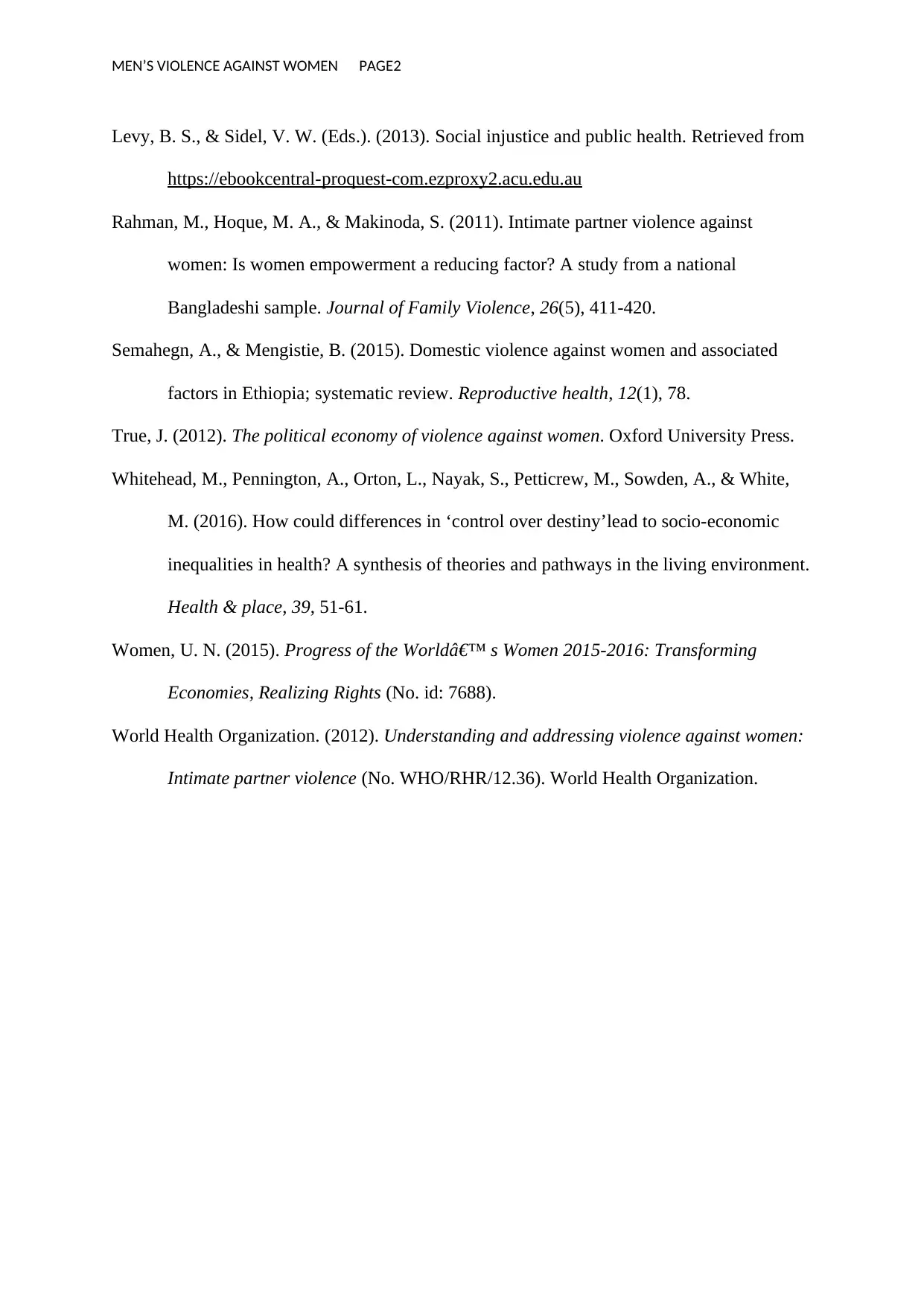
MEN’S VIOLENCE AGAINST WOMEN PAGE2
Levy, B. S., & Sidel, V. W. (Eds.). (2013). Social injustice and public health. Retrieved from
https://ebookcentral-proquest-com.ezproxy2.acu.edu.au
Rahman, M., Hoque, M. A., & Makinoda, S. (2011). Intimate partner violence against
women: Is women empowerment a reducing factor? A study from a national
Bangladeshi sample. Journal of Family Violence, 26(5), 411-420.
Semahegn, A., & Mengistie, B. (2015). Domestic violence against women and associated
factors in Ethiopia; systematic review. Reproductive health, 12(1), 78.
True, J. (2012). The political economy of violence against women. Oxford University Press.
Whitehead, M., Pennington, A., Orton, L., Nayak, S., Petticrew, M., Sowden, A., & White,
M. (2016). How could differences in ‘control over destiny’lead to socio-economic
inequalities in health? A synthesis of theories and pathways in the living environment.
Health & place, 39, 51-61.
Women, U. N. (2015). Progress of the World’ s Women 2015-2016: Transforming
Economies, Realizing Rights (No. id: 7688).
World Health Organization. (2012). Understanding and addressing violence against women:
Intimate partner violence (No. WHO/RHR/12.36). World Health Organization.
Levy, B. S., & Sidel, V. W. (Eds.). (2013). Social injustice and public health. Retrieved from
https://ebookcentral-proquest-com.ezproxy2.acu.edu.au
Rahman, M., Hoque, M. A., & Makinoda, S. (2011). Intimate partner violence against
women: Is women empowerment a reducing factor? A study from a national
Bangladeshi sample. Journal of Family Violence, 26(5), 411-420.
Semahegn, A., & Mengistie, B. (2015). Domestic violence against women and associated
factors in Ethiopia; systematic review. Reproductive health, 12(1), 78.
True, J. (2012). The political economy of violence against women. Oxford University Press.
Whitehead, M., Pennington, A., Orton, L., Nayak, S., Petticrew, M., Sowden, A., & White,
M. (2016). How could differences in ‘control over destiny’lead to socio-economic
inequalities in health? A synthesis of theories and pathways in the living environment.
Health & place, 39, 51-61.
Women, U. N. (2015). Progress of the World’ s Women 2015-2016: Transforming
Economies, Realizing Rights (No. id: 7688).
World Health Organization. (2012). Understanding and addressing violence against women:
Intimate partner violence (No. WHO/RHR/12.36). World Health Organization.
⊘ This is a preview!⊘
Do you want full access?
Subscribe today to unlock all pages.

Trusted by 1+ million students worldwide
1 out of 9
Related Documents
Your All-in-One AI-Powered Toolkit for Academic Success.
+13062052269
info@desklib.com
Available 24*7 on WhatsApp / Email
![[object Object]](/_next/static/media/star-bottom.7253800d.svg)
Unlock your academic potential
Copyright © 2020–2025 A2Z Services. All Rights Reserved. Developed and managed by ZUCOL.




